Oak and oak in Euskal Herria
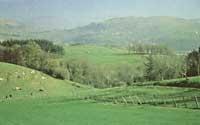
The research carried out in the last ten or fifteen years has allowed us to know quite well the situation of our forests. We have already developed vegetation maps and forest inventories that indicate how different plant communities are distributed or the extension of the main trees, among others.
It is widely known the ecological conditions in which each community is settled, as well as the potential vegetation existing in most territories, that is, the pre-existing vegetation before the transformation of the landscape by the human being, and that if nature is abandoned for a long time (hypothetical condition, of course) would be recreated and organized.
Therefore, the data is there to make an analysis of the current situation and take action for the future.
On oaks, two words
The word “oak” includes different species of the genus Quercus, mainly Quercus robur(=Q. pedunculata) or pedunculated oak and Quercus petraea or albar oak, being the first the most widespread in our lands. There are also other Quercus similar to oaks well separated by their name, such as the “marojo” Quercus pyrenaica, the “quejigo” Quercus faginea, the “roble pubescens”,... and the hybrids between those mentioned, a common phenomenon in the genus Quercus.
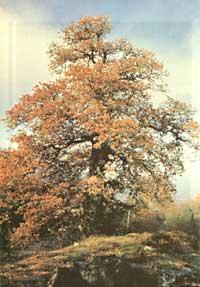
In these lines I will speak mainly of pedunculated oak, since the forests of this type of oak prevailed in wide territories of the Cantabrian slope
Around this species different communities, different forests are formed. In the broad sense, they are mainly of two types (we have to make more distinction when analyzing them in depth): those located in rich valley lands and ravines (with abundant ash) and those of slopes and hills. In both cases the dominant tree is oak, but the communities that are formed with oak (other trees, shrubs and herbaceous) have a big difference.
In this case it may be convenient to make a point clear. In most cases, forests are named after an arboreal species: oak, holm oak, beech, alisedas, etc., which is the dominant tree, but there are many other different trees and shrubs. For example, in the case of oak trees: ash, birch, heron, chestnut, maple, holly, gold, salvatierra, chicken coop, white hawthorn, etc.
M
robledals
The differences are mainly due to the characteristics of the lands, but as the pH is close to 7, the presence of a rather acidic soil (common case in the Basque rainy areas) has great influence.Oak adapts to both, but not many plant species found around it.
Another factor of differentiation is the humidity and freshness of the land and its surroundings, with a wide or very narrow valley, average annual temperatures (much colder in the Barranca de Navarra or the Llanada Alavesa than in the valleys of Gipuzkoa and Bizkaia),...
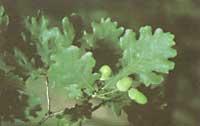
In the valleys and hills of the Cantabrian slope (reaching some territories of the Mediterranean slope), under the strait or enclave of the beech, most of the plot was occupied by pedunculated oak forests. On occasion, between these and the beech forests alternated pedunculated oak forests.
The holm oak also had a remarkable presence (especially in the area of Bizkaia) and also marojales; alisedas in all streams and margins.
If we could see a landscape thousands of years ago, we would encounter an almost continuous forest, or a set of different forests.
The shepherds began to open the widens and open the new ones, as they needed pastures for the animals.
With the creation of agriculture expansion intensified, turning the most suitable areas into agricultural land. The population increased considerably.
On the other hand, the need for wood for construction was increasing (houses, boats,...).

In the past, the carboneros dispersed throughout the forests, forming coal for a large number of ferrerías. Fortunately, nowadays there is no need for charcoal, but the remains of this action can be found very easily in our forests.
Finally, allochthonous (or foreign) species were planted for the rapid production of wood. By then there had already been the greatest reduction of forests.
The road to deforestation is therefore long, and for many centuries it was mandatory for the needs of the human population. At some point, however, the limits were exceeded, since native forests have not been preserved in reasonable quantity and quality. In them the oak trees are one of the most lost forests, since they currently occupy a very small area. Otherwise, let's look at some significant data that can be extracted from the Forest Inventory of the P.R.U.G. :
Oak trees in Bizkaia and Gipuzkoa (Quercus robur+Q. The area occupied by the petraea is 6,926 ha, regardless of the quality and maturity of the forests. If necessary it is a data from above. On the other hand, the “forests” planted for intensive wood production (which are mostly masses of rapidly growing and short conifers) occupy more than 176,000 hectares.
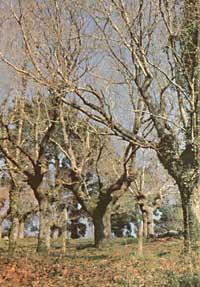
Plantations are necessary, but one must also look at the other. It should be noted that conventional plantations are completely simplified bushes, since most of the species that make up the real forests are missing. In addition, the form of exploitation and its effects (short to fact, risk of erosion on large slopes, short periods, etc.) do not favor nature. There is an obvious need for study on this point. You have to take advantage of the land... but looking ahead.
The true oak forests, taking into account the composition and development of the species and the extent required by the word forest, have become a curiosity, although the situation is better in Navarre.
Surely many young Basques have never crossed any oak groves and will not know how its interior landscape is. It is certainly a sign of loss of our culture and natural heritage.
The forests and bushes that have survived have been preserved both on steep slopes and in ravines, in the places most inadequate for the housekeeping. Most are located far from the state of the mature forest, with the shortage of solid or well shaped oak. On the other hand, the evil of Oidium is widespread in young oaks. It is not a deadly disease in many cases, but it weakens and ugly trees. And it is that these and the forests have been given “firewood” in our territories: necklace trees, cut several times branches for coal and wood, collect leaf litter, etc. In addition, to a certain extent there has been a negative selection, cutting in greater proportion the most beautiful trees.
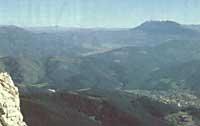
However, it is absolutely necessary to maintain what has come to us, since the communities, including oak, are made up of hundreds of plant and animal species and are very important elements in the landscape. The same must be said of other types of forests.
They are deposits of species and areas of dispersion for the forests of the future and parts of our nature mandatory for recovery.
Buletina
Bidali zure helbide elektronikoa eta jaso asteroko buletina zure sarrera-ontzian











